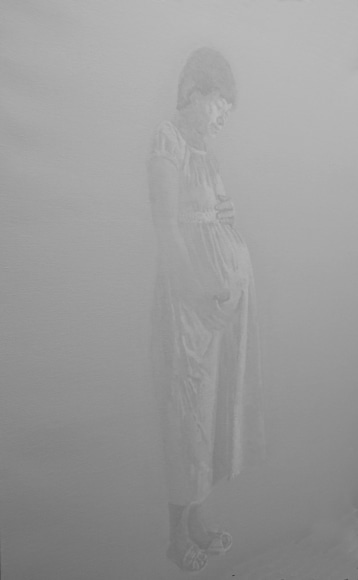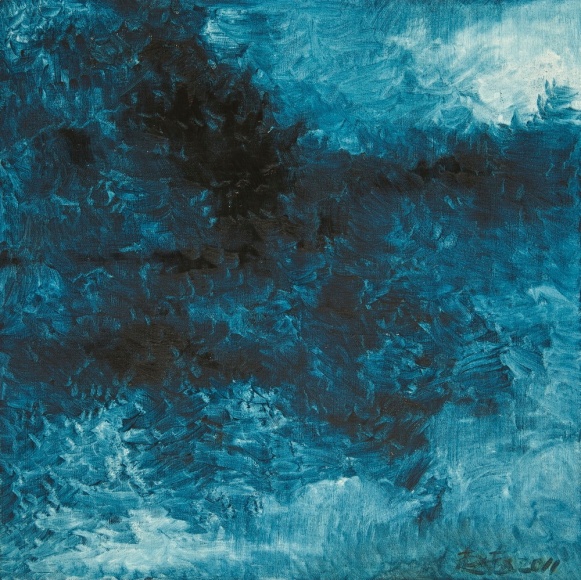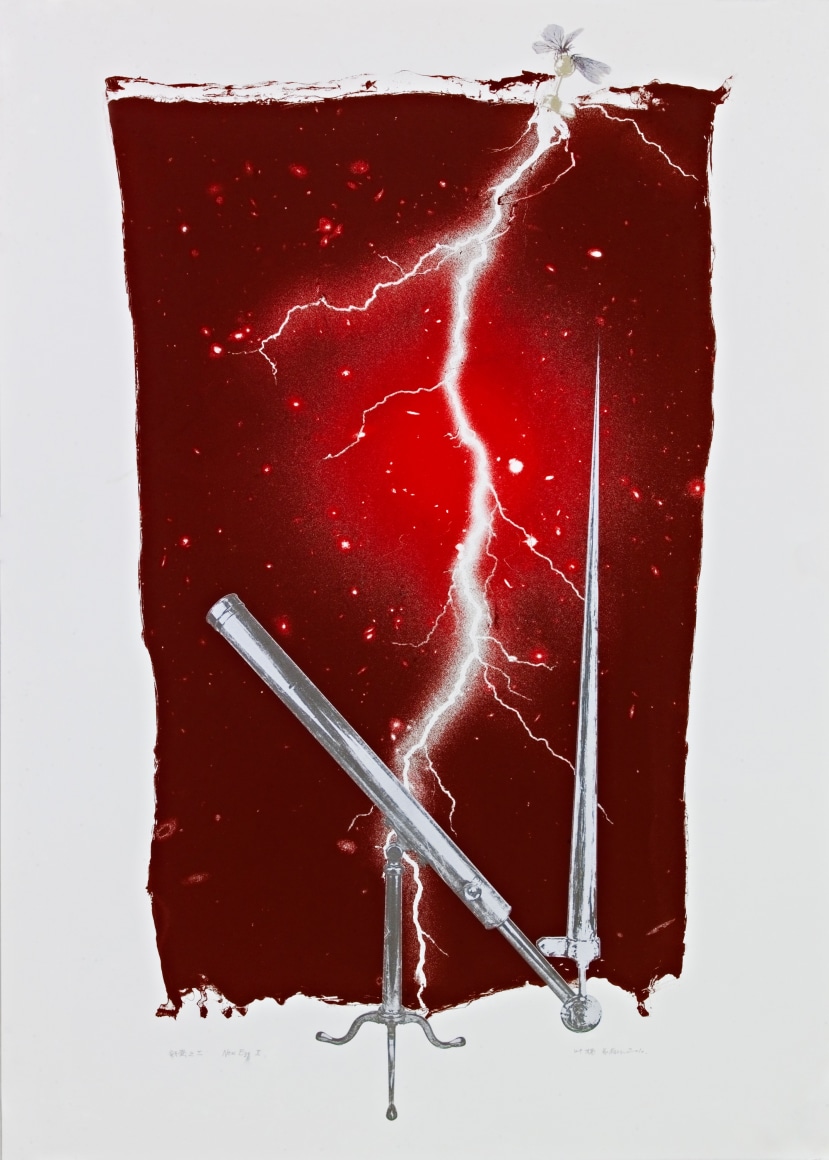There was a tendency in the 1990s for young artists who had been trained in oil painting to abandon it as soon as they graduated. There were, of course, notable exceptions, among them Xiaoze Xie and Shi Jing, born respectively in 1966 and 1971, who did not feel this need and continue working in the traditional medium of oil on canvas until the present day. The urgency to rebel against established rules that was such a force for change in the tumultuous decade of the 1990s has subsided to a considerable extent and younger artists such as Zhang Dun (b. 1979) and Guo Hongwei (b. 1982) tirelessly explore the expressive potential of the sharpened pencil on sheets of paper and the paint-loaded brush on canvas. This exhibition brings together the work of two mature artists and two younger artists at the beginning of their careers who find inspiration in the time-honored practice of conveying their observations of the world around them onto two-dimensional surfaces.
Xiaoze Xie was born in Guangdong in 1966. He graduated from Tsinghua University and the Central Academy of Arts and Design, Beijing before moving to the United States and settling in Texas where he continued his studies in a very different environment. As a realist painter by vocation, early on in his career Xie found a way to combine his passionate interest in aspects of Chinese history and current world events with more formal concerns by focusing on the materials stored in archives and library stacks as the subject matter of his paintings. Admitted to areas normally out of bounds to the general public, Xie found a rich source of material in library stacks ranging from the monochromatic bindings and pages characteristic of traditional Chinese books to the exaggerated colors of the photographs found in most contemporary newspapers and magazines.
The decaying volumes and manuscripts in the Chinese Library series which began in 1995 refer in general terms to China’s complicated history, to traditions that are on the point of disappearing before the onslaught of modernity that is characteristic of China today. In contrast, the newspaper paintings are multi-colored and specific in their references to current events, offering an unofficial history of the last decade.
Shi Jing was born in Dehongzhou, Yunnan Province in 1971 and currently divides his time between Beijing and Yunnan in the southwest of China. His work has been widely exhibited in China, including a solo show at the Today Art Museum, Beijing (2009) and the Nanjing and Guizhou Triennials in 2008. His work is entirely different in character from that of Xiaoze Xie, rejecting the specifics of appearance in favor of a philosophical investigation of the realities behind it. In the two works in the current exhibition, female figures emerge from what at first glance appear to be blank monochrome canvases. He achieves this effect by painting from the side, stippling the surface of the paint so that the image appears only when light passes across it from specific directions. If Xiaoze overwhelms the spectator with specifics, Shi does the opposite, draining the subjects he represents of all attributes, volume, weight and color. Of primary importance to him is the moment when the image suddenly appears, an apparition that is always on the verge of disappearing.
Zhang Dun was born in 1979 in Shenyang, Liaoning Province in Northeast China, a major industrial city, and has watched as once powerful industries have gone into decline, a process evident in the gradual physical deterioration of the physical structures that housed them. After graduating from the Lu Xun Academy of Fine Arts in 2003, she moved to Beijing and saw the entire process accelerated in the Dashanzi Art District (798) as it evolved from atmospheric decay to tawdry, shopping-mall chic in less than five years. Using photographs as aides-memoires and restricting the medium she uses to pencil on paper, she eliminates all signs of life, people as well as vehicles, any sense of movement or specific historical period in order to create these drawings in which time seems to have stopped still. Precise and airless and marked by abrupt transitions in perspective, her drawings are poetic distillations rather than precise recordings of things she has seen.
Guo Hongwei was born in Chongqing in 1982 and graduated from the Sichuan Fine Arts Institute in 2005. Once he graduated, he rapidly abandoned the approach that characterized the teaching at the Academy, favoring subject matter drawn from his childhood and often working from photographs in his family photo-album. In his oil paintings, seeking to disturb the slick surface of the oil paint, he diluted it with turpentine or splashed it with water in order to create unanticipated effects. Initially, his focus was on inconsequential objects that he found lying around in his studio, objects such as tooth-brushes, paper cups or the cardboard box in the present exhibition but as he gained in confidence the range of subject-matter expanded to include material such as the framed Impressionist paintings in the wittily titled Masterpiece. Floating in space, the gilt-framed paintings by Monet, Pissarro etc. that are the subject of the diptych become a series of masterful displays of painterly virtuosity, rivaling the masters at their own game!
北京前波画廊荣幸地宣布将于11月26日举办年轻艺术家群展《静修》,参展艺术家包括陈思平、董媛、付小桐、劳同丽、李洁、李旭伟和伍伟七位艺术家。随着中国经济和科技飞速的发展,我们同时也看到了艺术家在面对这一环境时所发生的变化。生存的压力、外界的诱惑与艺术创作上的瓶颈,多重的枷锁带来的极度焦虑和躁动不安,几乎所有艺术家都在思考着如何独辟蹊径。然而,在全球化的今天,独具匠心似乎已经成为了一种奢侈,艺术家很难再从绘画技巧或是媒材上超越前人,因此,如何寻求一个具有突破性的创作主题或题材成为了关键因素。
通常来说,我们会更加关注艺术家在作品中所涉及的社会叙事,文化或历史背景,因为它们不仅题材宏大,更记录了一个时代的发展。而此次展览,我们选择了另一个截然不同的视角,展览中的几位年轻艺术家的创作题材都源自于个人性情和趣味,或从日常经验中获得,更为值得一提的是他们的创作过程,通过如神游或修行般的重复与繁复工作以平衡现实世界所遭遇到的种种不安。
陈思平(1986年出生于福建)极具节奏感和秩序感的雕塑《游》呈现并传达了机械时代的文化语境和美学理解。他的雕塑作品没有现实物像的来源,而完全依靠天马行空的想象,螺旋和冷峻的几何元素在错落的空间中结合,让他在畅游的同时诠释了建筑的美感。与充满极简元素的雕塑不同,董媛(1984年出生于辽宁)的作品《四季》和《呐喊》由成百上千个奇幻的形象组成,这些形象每个都各不相同却互相关联,甚至身体共用同一部分。这些神秘的形象来自艺术家长时间盯着空画布所捕获的形态,并迅速画了下来,有些形态被描绘下来后甚至艺术家也无从知道是什么,她的整个创作过程似乎是在演绎一场意识流,毫无章法却形象生动。
劳同丽(1982年出生于广东)作品中的树纵横交错,重叠并缠绕绵延,犹如血脉;李洁(1970年出生于河南)作品中的螺丝钉被无限重复地堆积和穿插,并精心营造,重新彰显物性;付小桐(1976年出生于山西)作品中的山河由成千上万个不同方向的针孔组成;李旭伟(1979年出生于内蒙古)作品中的点线面皆由刮刀在涂有颜料的表面一笔一笔刮刻而成。他们几位艺术家每件作品都饱含时间和劳作的意义,如苦行僧般的修行过程宁静而致远。
伍伟(1981年出生于河南)的作品里将他对生命的思考结合了起来。在《金身》作品中,通过描摹散落在白纸之上带有自身生命特征的毛发,并用金粉反复沿着被描摹下毛发的边缘轮廓逐渐扩大,直到不同外轮廓线相互触及,犹如磁场般在毛发的周边不断放大和流动。《光与黑暗》中放大了与人类生命息息相关的疾病病毒的形态,并赋予金属颜料的光感,同时借用星空的观看和呈现方式,将生命的不可预知性凸现出来。与此相呼应的还有艺术家通过将类似动物身体的纸质皮毛赋予反常形态和色彩的《皮毛》作品,也是对生命脆弱和不可预知的探索。
我们相信,艺术家在经历过身体的苦修和心理的挣扎后会碰撞出更多的可能性,而这些细微的可能性,也许正是我们在对未来和未知世界的探索。




